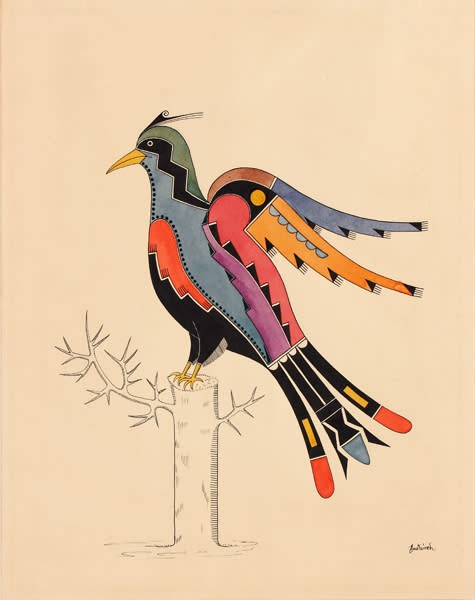Newark Museum of Art
Current NMOA Exhibitions
In the fall of 2016, the Newark Museum of Art will unveil its newly redesigned Native American galleries. Featuring more than 200 objects from throughout the United States and Canada, Native Artists of North America will present a fully reinterpreted selection of works from the Museum’s permanent collection, dating from the early 19th century to the present, including many objects never before exhibited. This long-term installation opened to the public on October 22, 2016.
In the fall of 2016, the Newark Museum of Art will unveil its newly redesigned Native American galleries. Featuring more than 200 objects from throughout the United States and Canada, Native Artists of North America will present a fully reinterpreted selection of works from the Museum’s permanent collection, dating from the early 19th century to the present, including many objects never before exhibited. This long-term installation opened to the public on October 22, 2016.
The Newark Museum of Art began collecting Native North American Art in 1910, and that collection has grown to more than 2,000 works of indigenous art from the continental Unites States, Alaska, Hawaii, and Canada. While the arts of the Americas include more than 4,000 objects, ranging from Alaska to Argentina and spanning the pre-Columbian era to the present, Native Artists of North America will focus on highlights from Newark’s comprehensive North American collection.
By situating the new galleries at the entrance to the permanent installation of American Art, which will be renamed Seeing America, the Museum reinforces the curatorial philosophy that Native American art is a crucial part of American art.
“This exhibition is about widening the story of American history to include underrepresented artistic and cultural voices, and introducing Newark and New Jersey audiences to American Art that better reflects them and the world around them,” said Steven Kern, the Museum’s Director, and CEO. “This newly expanded introduction to Seeing America will set the tone for the inclusion of multiple voices as visitors continue through the galleries.”

Awa Tsireh (Alfonso Roybal; 1898-1955), San Ildefonso Pueblo, New Mexico Bird, ca. 1930.
Watercolor and black ink on paper, 14 1/16 x 11 1/16 in. Gift of Amelia Elizabeth White, 1937 37.224
Twenty-seven tribal nations are represented in Native Artists of North America, grouped roughly by region to represent the richness of distinct geographic areas and the diversity of living tribal cultures. The result of a collaborative curatorial process involving a number of internationally recognized Native American artists and scholars, the objects on view are organized to highlight the strengths of the collection, including Northwest Coast (Haida, Tlingit, and Tsimshian), Northern California (Pomo) and the Southwest (Pueblo watercolors and pottery, and Navajo and Hopi textiles).
Among the works on view will be exquisitely woven Pomo baskets, hand-made items of dress from across the continent, and southwestern pottery and textiles. Other highlights will include works by the Haida master carver Charles Edenshaw and a rare Bear rattle attributed to the 19th-century Haida carver Sdiihldaa/Simeon Stilthda. Pueblo watercolors are another strength of Newark’s holdings, with strong examples by leading painters such as Fred Kabotie, Tonita Peña, and Awa Tsireh. Additional works by contemporary Native artists will be installed both within Native Artists of North America and in nearby galleries of modern and contemporary American Art and Decorative Arts.

Zuni artist, New Mexico. Water Jar, ca. 1890.
Clay, pigments, 11 in. high. Purchase 1913 13.319
“This permanent installation celebrates the great diversity of styles, media, and creativity of Native artists and places them in a broader context,” said Tricia Laughlin Bloom, Ph.D., Curator of American Art and Project Director for the reinstallation. “By placing these collections within our American galleries, we are able to draw out some wonderful connections and to highlight the ingenuity and creativity of Native artists past and present.”
A major commission by contemporary artist Jeffrey Gibson (Cherokee) will stand at the physical crossroads of the Native American and American galleries, at the center of the Mary Sue Sweeney Price and Clement Alexander Price Atrium. Titled Come Alive! (I Feel Love), Gibson’s handcrafted figural sculpture is covered from head to toe in a variety of beads, jingles, and arrowheads.
The lead curator for the exhibition is Adriana Greci Green, Ph.D., a research collaborator at the National Museum of Natural History, Smithsonian Institution, and (as of September 2016) Curator of the Arts of the Americas, The Fralin Museum of Art at the University of Virginia. Dr. Greci Green is a scholar of Native American art histories with an emphasis on Plains and Great Lakes arts, material culture, and cultural performances.
Consulting curators are:
- Sherrie Smith-Ferri, Ph.D. (Dry Creek Pomo-Coast Miwok), director, Grace Hudson Museum, Ukiah, CA; leading scholar of Pomo basketry and culture.
- DY Begay, Diné (Navajo), independent curator and internationally recognized weaver.
- Susan Sekaquaptewa (Hopi), independent curator, and internationally recognized scholar of Hopi culture.
- Emil Her Many Horses (Oglala Lakota), associate curator, the National Museum of the American Indian; curator and scholar of Central Plains cultures and curator of the exhibition Unbound: Narrative Art of the Plains, currently on view at the National Museum of the American Indian in New York.
- Mique'l Dangeli, Ph.D. (Tsimshian and Tlingit Nations), assistant professor of Alaska Native Studies at the University of Alaska Southeast and co-founder of Git Hayetsk, an internationally renowned Northwest Coast First Nations mask-dancing group located in Vancouver, British Columbia.
The opening of Native Artists of North America represents the first phase of Seeing America, an ongoing reinstallation of the American Art galleries highlighting the diversity of the American experience through Newark’s rich collections. Seeing America will feature new permanent installations of Latin American, African-American and Native American art from the 19th through the 21st centuries integrated throughout the chronological narrative of American art that the galleries present.
Photo credit (header): Tsimshian artist, British Columbia. Frontlet, 19th century Wood, paint, and abalone shell, 8 ½ x 8 x 5 ½ in. Gift of Dr. William S. Disbrow, 1919 19.775







